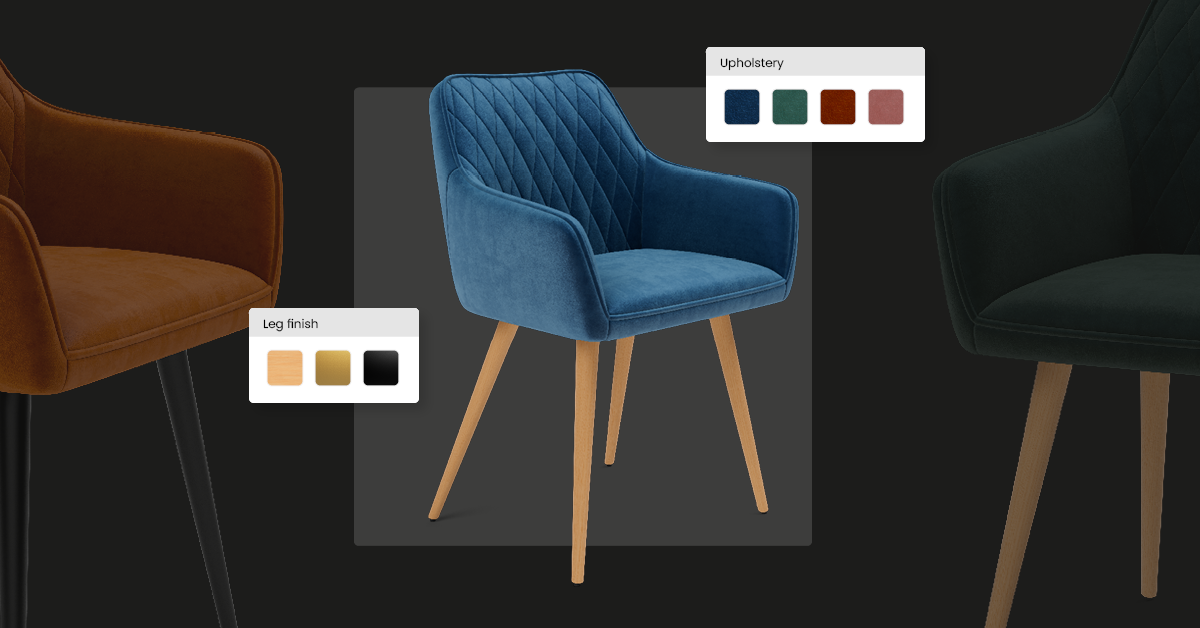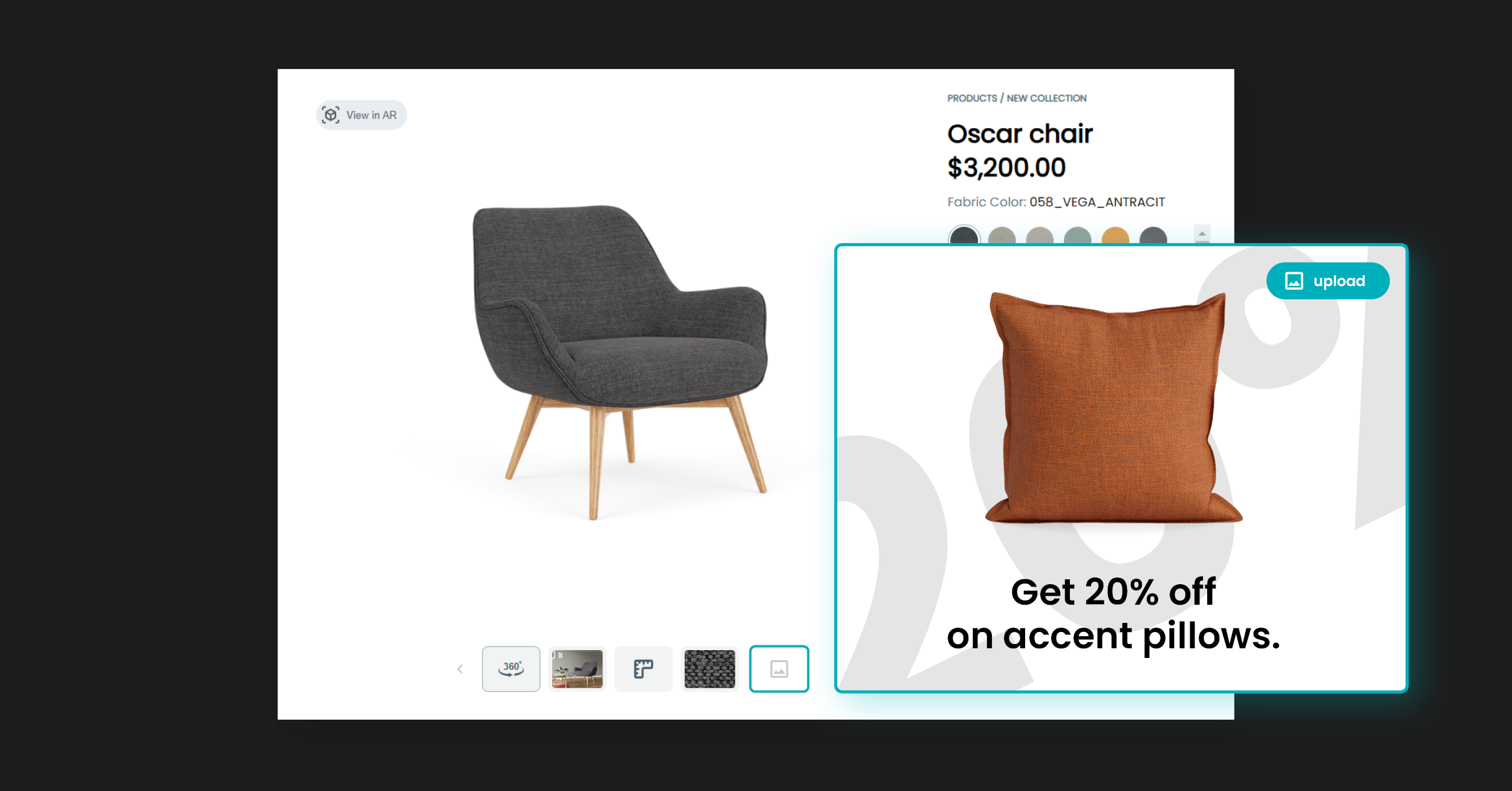Key Points:
-
Product Customization is a Market Imperative: Evolving customer expectations mean consumers now prefer tailored products, with 76% willing to pay more for personalized furniture. Customization is a crucial business strategy that fosters brand loyalty, opens new revenue streams, and is necessary for standing out in the competitive e-commerce market.
-
Customization Spans Multiple Types and Benefits: Customization includes four main types: Make-to-Order, Personalization Options, Design-Your-Own, and Variant Options/Add-ons. These strategies significantly boost conversion rates, increase sales (by up to 20%), and reduce return rates (by up to 40%).
-
Technology is Key to Seamless Implementation: Successful implementation relies on integrating the right e-commerce platform and 3D product visualization software (like product configurators) to offer real-time, engaging customization. These tools simplify the process, build customer confidence, and create a positive post-purchase experience, which ultimately drives brand trust and long-term retention.
Today, you're more likely to encounter someone who wants a product tailored to their unique tastes and preferences, than a person looking to buy a mass-produced piece.
The reason? Customer shopping habits and expectations for a delightful e-commerce customer experience have evolved. In fact, 76% of customers are willing to pay more for a piece of furniture that's tailored to their preferences.
This is a staggering statistic that highlights the power of product customization in today's market, allowing companies to offer bespoke, customizable products that drive business success and brand loyalty. But what exactly does it entail, and how can you leverage this strategy to stay ahead of the competition? Let’s dive in.
What is product customization?
Product customization refers to the process of modifying a product to meet the specific needs or preferences of an individual customer, involving changes to its design, features, or functionality. This approach enables businesses to cater to consumer preferences, staying ahead of market competition and design trends. By offering personalization strategies, companies can foster brand loyalty, as customers appreciate the unique experience and attention to detail.
In today's fast-paced market, product customization has become a crucial aspect of business strategy. With the rise of e-commerce and social media, consumers are exposed to a vast array of products, making it challenging for businesses to stand out. By incorporating customization options, companies can differentiate themselves and create a competitive edge. Additionally, product customization allows businesses to respond to changing consumer demands and preferences, ensuring they remain relevant in the market.
Effective product customization requires a deep understanding of consumer behavior and preferences. By analyzing market trends and consumer data, businesses can develop targeted personalization strategies that resonate with their target audience, and drive brand loyalty and advocacy.

In the age of mass production, product customization offers a revitalizing alternative, allowing businesses to connect with customers on a more personal level and build lasting relationships. By embracing product customization, businesses can open up new revenue streams, improve customer engagement, and ultimately, drive growth and success. As the market continues to evolve, product customization will remain a key driver of business innovation and success.
Types of product customization
Understanding the types of product customization can help customers choose the best options for their needs and styles. Whether it's sporting goods, personalized notebooks, or make-to-order sofas that fit perfectly in your customers’ living rooms, each type offers unique benefits. Let's explore how these customization choices can enhance the overall shopping experience.
1. Make-to-order customization
Among the various types of product customization, make-to-order stands out for allowing customers to specify their preferences, leading to the creation of unique items solely after an order is placed. This method of make-to-order customization greatly empowers customers by ensuring that each product perfectly meets the individual's expectations as the entire product is created based on customer specifications.
One of the key benefits of make-to-order customization is the potential for premium pricing. This boosts sales and conveys a perception of higher quality and exclusivity to customers. Additionally, make-to-order customization helps businesses better align with consumer demand, reducing the risk of overproduction and unsold inventory. By producing items only after an order is placed, you cut down on excess waste, contributing to more sustainable business practices.
2. Personalization options
Beyond the flexibility of make-to-order customization, businesses can explore various personalization options that cater to their customers’ unique preferences, including custom text, size, color, material, and design choices that let customers tailor pre-existing products to their individual styles. These personalization options enable them to reflect their personality, making mass-produced products one-of-a-kind.
To enhance this experience, furniture businesses use visual customization tools and advanced techniques like 3D visualization, enabling the creation of one-of-a-kind custom products, and allowing customers to see real-time changes as they make their selections. This helps them make informed decisions and increases engagement with the product. For instance, selecting a blue leather cover for a couch or adding monograms becomes a breeze when you can instantly visualize the outcome.
3. Design-your-own product
Design-your-own product customization is similar to made-to-order customization, however, customers only have design control over certain, not all components. This approach empowers customers to create unique items by selecting specific attributes like color, size, and material from a limited selection to tailor a product to their tastes and preferences.
Offering design-your-own product options doesn't just increase customer engagement; it also drives purchasing decisions. Research shows that 36% of consumers prefer custom products, indicating a strong market for businesses that provide design-your-own customization. This model enables customers to infuse their personal touch into each item, making it truly unique.
Plus, design-your-own online product customization options can help reduce return rates. By aligning more closely with customer expectations and desires, these personalized items are less likely to be returned, ultimately benefiting the business's bottom line.
4. Variant options and add-ons
You're presented with a range of choices when it comes to customizing products, and variant options and add-ons take one step further by letting you tailor specific attributes and features of a standard product to fit your needs. When using product customizer software you provide variant options, you let customers pick from different sizes, materials, and other attributes, further tailoring their purchases to their specific needs. Add-ons, on the other hand, are additional functionalities or features that customers can include, making their products even more aligned with their individual preferences.
To guarantee a seamless experience, it's essential to have a clear and intuitive customization interface. This reduces customer confusion and streamlines the process of selecting various product variants and add-ons. By incorporating these elements, you'll likely see a deeper connection with your audience.
The benefits of product customization
You'll discover that product configuration offers a plethora of benefits, beginning with an enhanced online shopping experience that caters to individual tastes. Furthermore, integrating the best product configuration software in your online store that allows customers to virtually try on features in real-time can greatly elevate customer perception of your brand, fostering long-term relationships and encouraging repeat purchases as customers return to create more personalized pieces for their homes.
1. Improving the online shopping experience
Offering product customization in your online store is one of the many ways to greatly enhance the customer experience by aligning products with individual preferences and needs. When you allow customers to personalize products, it leaves a lasting impact on their shopping experience, making it more engaging and meaningful. By offering product customization, e-commerce brands can create compelling customer experiences, greatly boosting sales.
Using visual product customizers in your e-commerce store, where customers can see changes in real time, builds confidence and makes customers happier. This minimizes shopping cart abandonment and leads to higher purchase commitment. Additionally, when customers design their products, return rates can drop by up to 40%.

Lastly, satisfied customers are more likely to leave positive reviews and share their personalized products on social media, enhancing word-of-mouth marketing. By offering these options, you greatly improve the online shopping experience, promoting deeper customer engagement and loyalty.
2. Increased sales and revenue through customized products
By offering customized products, businesses can greatly boost their revenue, with prices going up to 20% more than standard offerings. This is because they are perceived as unique and personalized, providing customers with a sense of control and satisfaction. As a result, you can expect increased sales and revenue growth. When you offer custom made furniture, you're catering to individual preferences, which leads to a higher perceived value and a willingness to pay more.
By incorporating product customization, businesses are not just driving revenue growth but are also setting themselves apart from competitors. By understanding customer needs and utilizing technology to create tailored experiences, you can create a loyal customer base that drives repeat purchases. With customized products, you can create a competitive edge in the market, ultimately leading to increased customer happiness and long-term revenue growth for your e-commerce business.
3. Enhancing customer loyalty and brand perception
Effective product customization enhances customer loyalty and brand perception by fostering strong emotional connections with customers who are considerably more likely to return for repeat purchases. By catering to individual preferences and offering customizable products, businesses can create a sense of belonging and exclusivity among their customers, making them feel valued and understood. This in turn serves to differentiate your brand in a crowded market, setting you apart from competitors and establishing a positive brand reputation.

Moreover, tailored choices and personalized experiences are key purchasing drivers, with 80% of loyal customers preferring brands that offer customized experiences. By providing unique options, businesses can build trust and credibility, leading to a significant increase in customer loyalty. By investing in product customization, businesses can reap long-term benefits, including improved brand perception and a loyal customer base.
4. Improving customer satisfaction and post-purchase experience
By tailoring products to individual preferences, you can greatly boost conversion rates, with successful product personalization programs showing a 20% increase in satisfaction. Product customization allows customers to feel more connected to the products they purchase, leading to a significant improvement in their overall post-purchase experience. This personalized experience builds emotional connections, which lead to brand loyalty and advocacy.
Combining product customization with 3D product visualization software brings several key benefits, including:
- Increased brand loyalty: 36% of customers will choose to return to a brand after a positive experience, even when more affordable or convenient options are available.
- Lower return rates: 3D tools contribute to a reduction in product returns, with 39% of furniture firms considering it a critical priority and 52% deeming it a high priority. Providing a more accurate product representation is proving to be a winning strategy in enhancing customer satisfaction and operational efficiency.
- Higher customer engagement: 3D product visualization has a significant impact on key business metrics, driving a surge in average order value (69%) and customer engagement (58%). The adoption of this technology has also allowed businesses to reduce product visualization costs (39%).

Free report: Tech trends impacting the furniture industry: from AI to 3D product visualization
Implementing product customization
To successfully integrate product customization into their e-commerce store, companies must carefully select an e-commerce platform and product visualization software that have seamless integration, streamlining the entire customization process from design to delivery.
Key steps for effective implementation include:
-
Platform Selection and Integration: Companies must evaluate platforms based on their ability to handle complex customization options, provide user-friendly interfaces, and integrate seamlessly with existing inventory management systems to guarantee outstanding customer experiences.
-
Customer Feedback and UX Focus: Effective strategies involve staying on top of design trends and actively incorporating customer feedback (via social media, surveys, and reviews). Businesses must prioritize user experience, providing intuitive and interactive customization tools that simplify the design and visualization process.
-
Technical Planning and Scalability: A well-planned production customization strategy must address technical aspects, including integration with existing systems and ensuring the software is scalable. Investing in a robust and flexible platform is essential to future-proof customization capabilities.
Ultimately, successful implementation requires a combination of technical expertise, design acumen, and a deep understanding of customer needs and preferences to unlock the full potential of product customization and drive growth.
Examples of successful product customization
While made-to-order products are often synonymous with smaller or very exclusive brands, there are many product customization examples among furniture retailers as they offer a wide range of options for their product lines.
1. Coco Republic
One excellent example is the Australian furniture brand Coco Republic. While a big portion of their products are customizable in terms of fabric and color, they also offer ‘design your own’ customization to the Omega Modular Sofa. For this sofa, customers can choose the configuration of the sofa, fabric type, and color and see how it would look in just a few clicks. This level of customization allows customers to arrange and design the sofa to perfectly suit their living space and style requirements.

2. Interior Define
Another furniture business that emphasizes product customization is Interior Define. The brand was created in 2014 to provide made-to-order sofas at a competitive price point. Today, they offer product customization options for their 25+ style collections, more than 20 leg options, 150+ fabrics, and a variety of dimensions to develop their one-of-a-kind furniture. This way, Interior Define created a frictionless online shopping experience.
For example, customers looking at their James 3-Piece U-Bumper Sectional can add a personal touch and select from the multitude of customizable options, including fabric type and color, size, size, depth, bumper depth, cushion type, and fill. Additionally, for customers who want to take things further, there’s the option to schedule a consultation with a design expert who can help them choose the right product customizations, and even provide floor plan and decoration advice.

Product Customization Tools
Product configurators have revolutionized the way customers interact with and personalize their furniture choices. These digital tools enable shoppers to customize products in real-time, selecting various options such as size, color, material, and additional features. By providing a visual representation of the final product, configurators bridge the gap between imagination and reality, making the customization process both engaging and efficient.
Configurators can provide detailed information about each option, from fabric durability to colorfastness, further aiding in informed decision-making. This real-time feedback reduces uncertainty and helps customers feel more confident in their choices.
By making the customization process simple and enjoyable, retailers can enhance customer satisfaction and increase the likelihood of purchase completion.
Bring your products to life with product customization
Implementing product customization can ultimately become a prime competitive differentiator for your business, setting you apart in crowded markets. The key to success lies in empowering customers by giving them control and allowing them to share their own experiences.
By leveraging user-friendly modular furniture design software and innovative 3D visualization tools, companies can create a seamless experience, driving revenue growth and satisfaction. As the adage goes, 'variety is the spice of life,' and product customization is the key to adding that extra pinch of flavor to the customer experience. Effective implementation can lead to long-term success, making it an essential strategy for businesses in today's market.
Ready to create immersive visual experiences for your customers? Let’s talk.




